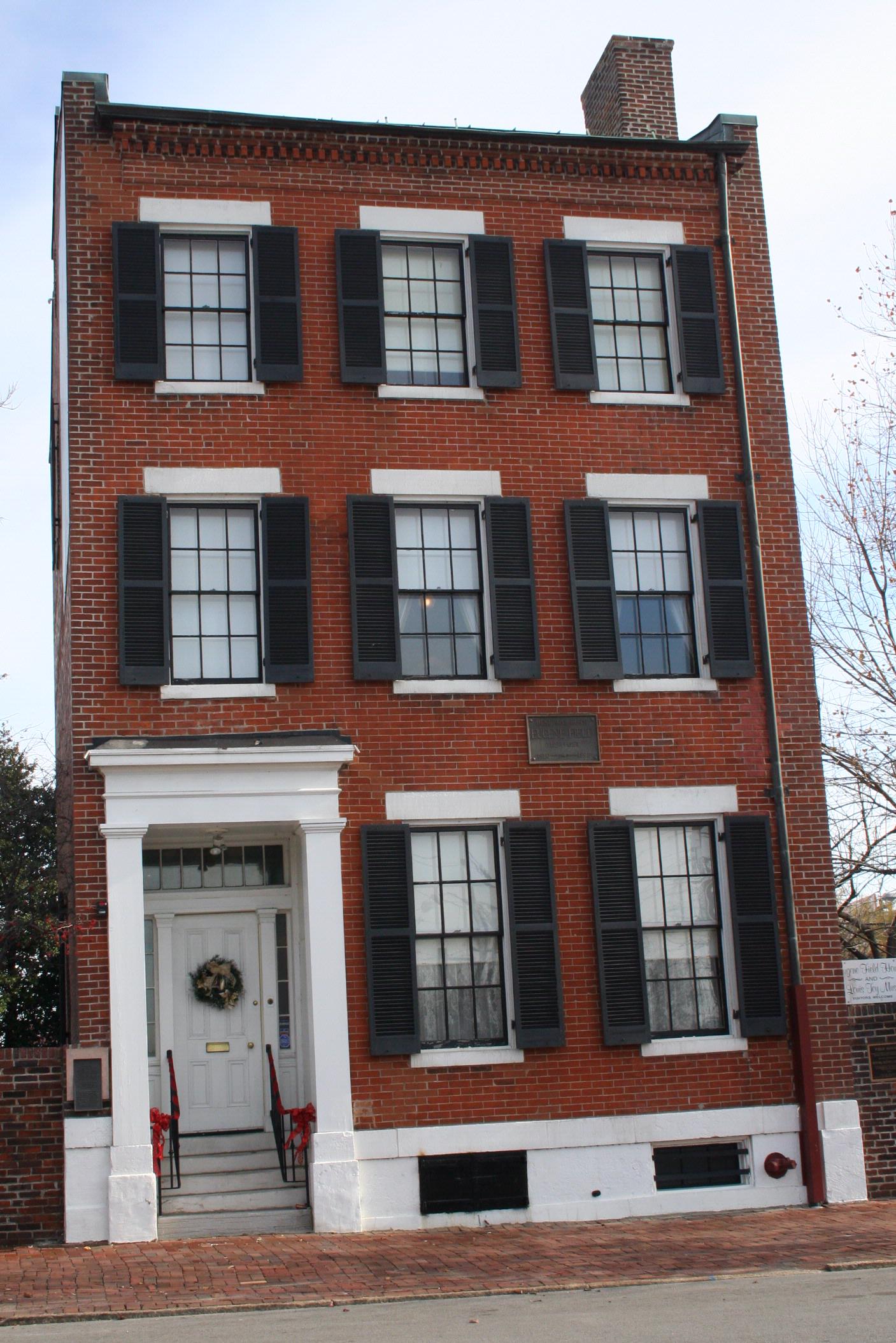High Style Town Houses
Federal Town Houses

The Eugene Field House, at 634 South Broadway, constructed in 1845, was once part of a row of identical Federal style town houses. The three-story brick house is three bays wide and two rooms deep, with a side passage. The windows, which are six-over-six, and the recessed entry are set beneath stone lintels. The entry has sidelights and a transom. Decorative details include a stone watertable, corbelled cornice and Baltimore chimneys. When constructed, this row of houses was one of the most fashionable in the city. The Field House has been restored as a museum.
Greek Revival Town Houses
The Greek Revival style town house was never widely popular in St. Louis: today examples of the style are very rare. Like rural counterparts, the primary component is the temple front, which was often seen in grand, detached town houses. However, even in more modest representations, the traditional Greek Revival imagery could be found. Greek Revival town houses are most likely to be seen east of Jefferson Avenue, in the Carondelet or Old North St. Louis neighborhoods.
The house at 2519 Blair, in Old North St. Louis, is a typical St. Louis Greek Revival town house. The side passage house is two stories tall, three bays wide, and three bays deep. The recessed entry, crowned by a classical pediment, is positioned at the left of the front facade. Windows are two-over-two, probably a later alteration. One window has original exterior shutters, and it is quite possible all the windows did at one time. The major feature of the house is the front gable, which serves in the role of temple front. It has a pronounced wood cornice with large returns, highlighted with dentils.
The house at 6517 Michigan is another Greek Revival design. What distinguishes this two-story frame house is not a temple front: instead, the house uses the arrangement of three bays, tall, narrow windows and doors, and gabled roof to generate the Greek Revival character of the house. The first story windows, taller than those on the second story, give a verticality to the house that is similar to the role played by pilasters in more typical Greek Revival houses. Again, the pediment of the temple front is reproduced by a front gable with heavy cornice.
Renaissance Revival Town Houses
The Renaissance Revival town house was a relatively rare house type, with few examples built in St. Louis during the period of its national popularity, around the time of the Civil War. It is derived from the architectural vocabulary of houses constructed by the powerful merchant class in Italian city-states of the 16th century. Renaissance Revival houses are always of brick or stone, often somewhat austere rectangular boxes with little exterior detailing, except for elaborate window heads and less exuberant molded cornices. Decorative quoins at corners are a hallmark of the style.
The Henry Shaw City House, 1851, an almost prototypical Italian Renaissance Revival example, was designed by George I. Barnett. It was located at the corner of 7th and Locust Streets until 1891, when, as Shaw had requested in his will, it was dismantled and moved to its current site at the Missouri Botanical Garden. The three-story brick house has a low-pitched, hipped roof and recessed entry, which is emphasized by a pedimented surround. Windows on first and second stories also have pediments; those of the third story are arched. A two-story wing with arcade is attached to the south side of the house. An addition was made to the building in 1907, which replicated the original block.
Italianate Town Houses
The Italianate style was widespread in St. Louis buildings through the 1880's. Found in detached houses as well as row houses, the range of Italianate detail was wide. Distinctive features of the style are quoins (sometimes imitated in brick), pronounced cornices with paired brackets, and tall, narrow windows set under segmental arches. The new availability of prefabricated cast iron details for cornices and window heads allowed a wealth of decorative detail to be added to the humblest building.
The house at 1227 Sullivan, in Old North St. Louis, is a particularly fine example of St. Louis Italianate. The house is two stories in height, with three bays on the front facade. Cast iron is used for the lintels that decorate each window and door opening on the front, and for the wide projecting cornice with paired brackets. Windows are tall, two-over-two sash.
The two-family house at 1302-04 Warren Street, another Italianate town house example, is six bays wide, with centered entries. Windows are tall, narrow two-over-two sash (here with their original shutters). A delicate wrought iron balcony extends across the three center bays. The house has a pronounced, bracketed cornice and two symmetrically placed dormers on the gable roof.
Eclectic Town Houses
Not all houses built during the Walking City period strictly followed one stylistic format. The Campbell House, at 1508 Locust Street, was constructed in 1851. The house is three bays wide, three stories tall, and two rooms deep. The main block of the house appears to be a Federal town house, and the windows have rectangular stone lintels, a Federal attribute; but the tall, narrow proportions of the windows and the bracketed cornice show Italianate influence. The wood surround of the main entry, conversely, is taken directly from the Greek Revival. The house is now a museum; a modern addition for offices has been constructed at the rear.
Previous Page Next Page